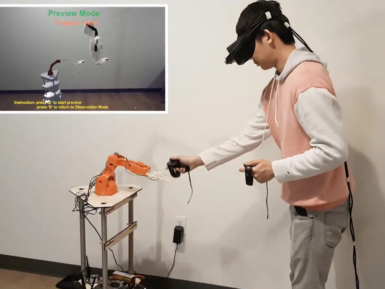
Grove - Thumb Joystick
Sold outGrove - Thumb Joystick is a Grove compatible module which is very similar to the ‘analog’ joystick on PlayStation 2 controllers.
Overview
The X and Y axes are two ~10k potentiometers which control 2D movement by generating analog signals. The joystick also has a push button that could be used for special applications. When the module is in working mode, it will output two analog values, representing two directions. Compared to a normal joystick, its output values are restricted to a smaller range (i.e. 200~800), only when being pressed that the X value will be set to 1023 and the MCU can detect the action of pressing.
Features:
- Grove Interface
- 5V/3.3V Compatible
- Analog Output
Tech specs
|
Item |
Min |
Typical |
Max |
Unit |
|
Working Voltage |
4.75 |
5.0 |
5.25 |
V |
|
Output Analog Value (X coordinate) |
206 |
516 |
798 |
\ |
|
Output Analog Value (Y coordinate) |
203 |
507 |
797 |
\ |
Get Inspired

As robotics advance, the future could certainly involve humans and automated elements working together as a team. The question then becomes, how do you design such an interaction? A team of researchers from Purdue University attempt to provide a solution with their GhostAR system. The setup records human movements for playback later in augmented reality, while a robotic partner is programmed to work around a “ghost” avatar. This enables a user to plan out how to collaborate with the robot and work out kinks before actually performing a task. GhostAR's hardware includes an Oculus Rift headset and IR LED tracking, along with actual robots used in development. Simulation hardware consists of a six-axis Tinkerkit Braccio robot, as well as an Arduino-controlled omni-wheel base that can mount either a robot an arm or a camera as needed. More information on the project can be found in the team's research paper. With GhostX, whatever plan a user makes with the ghost form of the robot while wearing an augmented reality head mount is communicated to the real robot through a cloud connection – allowing both the user and robot to know what the other is doing as they perform a task.The system also allows the user plan a task directly in time and space and without any programming knowledge.First, the user acts out the human part of the task to be completed with a robot. The system then captures the human’s behavior and displays it to the user as an avatar ghost, representing the user’s presence in time and space.Using the human ghost as a time-space reference, the user programs the robot via its own ghost to match up with the human’s role. The user and robot then perform the task as their ghosts did.






